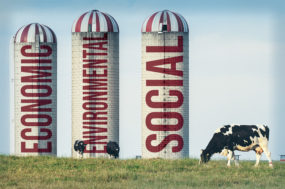Two years ago, Cairns purchased two robotic milkers and built a new barn to accommodate them.
Before the contractors began in 2009, Cairns spent two years planning the project. Once on the ground, the contractors began by tearing down the old corrals to provide room for the new barn.
Groundwork preparations started in May and six months later the cows stepped hoof in the new barn.
“Things were pretty organized with the contractors,” Cairns recalls. “It was a busy summer, but it all paid off.”
The barn was designed to specifically house the two robots. It makes a continuous circle. There are two rows of head-to-head stalls with feed on one side and a pre-selection gate for the robot on the other.
There is a confined area in front of each robot to direct cows toward milking. Once cows exit the robot, they can be let into a special-needs area or back with the main herd.
“In all areas of the barn there is water and places for the cows to lie down,” Cairns explains. “There is no specific confinement area, except in front of the robot.”
Cairns had to get used to keeping the cows indoors all the time. Not knowing what to expect with a total confinement barn, Cairns says the only thing he might change about his barn would be the mats that were put in the stalls.
“We were used to cows being outside,” Cairns says. “Now with cows in confinement it is much more critical that there are comfortable places for them to lay.”
Cairns says that feet and legs are so much more important now in the robot system than they were in the herringbone parlour.
“With cows coming up on their own, if they don’t feel well or have a little bit of a sore foot, you have to chase them up,” Cairns explains. “If you make your cows healthier, then they will feel good all the time.”
Keeping cows content is something that takes constant supervision. The partially mixed ration (PMR) fed at the bunk must have just enough grain to keep the cows satisfied, but also wanting more. Additional grain is fed at the robot.
“If the cows get too much grain in any one spot, they won’t go into the robots,” Cairns says. “They have to be craving energy to move around the barn.”
Cairns says that even with the new system there are drawbacks. Someone always has to be on call in case the robot shuts down in the middle of the night.
Each producer can set the robot to call about certain problems only when the producer thinks it is necessary. Cairns has his robot only call him at night if it shuts down.
“Before, when we were done milking you could go away and leave it,” Cairns says. “Now you have some more freedom, but you don’t want to go too many miles away.”
One adjustment to installing the robots was learning all of the technology that goes along with it.
“We went from a very simplistic dairy barn to a very modern dairy barn with all of the complexities,” Cairns says.
What many dairy farmers don’t realize, Cairns says, is how much extra work is done in the parlour. Whether producers are treating for mastitis or breeding their cows, the time is spent in the parlour, not outside of it. He found he has to adjust his schedule now to make sure those tasks still get finished.
“You have to make time to go and do those things,” Cairns says. “That is something different and out of your routine.”
The hours needed to take care of the cows are still put in, just in different ways. Jumping into a technologically advanced barn has given Cairns plenty of things to learn, but he says, even with the learning curve and irritating phone calls, he would not switch back to milking in a parlour. PD
PHOTO:
The barn was designed to specifically house the two robots. It makes a continuous circle. There are two rows of head-to-head stalls with feed on one side and a pre-selection gate for the robot on the other. Photo courtesy of Cairnside Farm.
-- From PD Staff Ariel Waldeck news release








